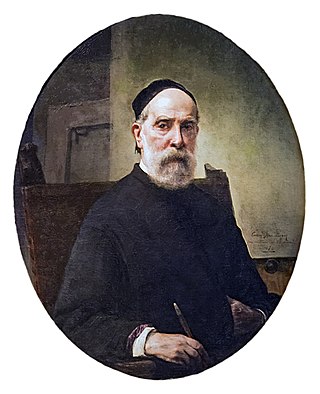
Luca Giordano was an Italian late-Baroque painter and printmaker in etching. Fluent and decorative, he worked successfully in Naples, Rome, Florence, and Venice, before spending a decade in Spain.

Francesco Hayez was an Italian painter. He is considered one of the leading artists of Romanticism in mid-19th-century Milan, and is renowned for his grand historical paintings, political allegories, and portraits.

Giambattista Pittoni or Giovanni Battista Pittoni was a Venetian painter of the late Baroque or Rococo period. He was among the founders of the Academy of Fine Arts of Venice, of which in 1758 he became the second president, succeeding Tiepolo.

Gregorio Lazzarini was an Italian painter of mythological, religious and historical subjects, as well as portraits. One of the most successful Venetian artists of the day, a prominent teacher, and father to a significant school of painting, he is best known for having first trained Giambattista Tiepolo, who joined his workshop in 1710 at the age of fourteen. His own style was somewhat eclectic.

Francesco Zugno was an Italian painter of the Rococo period who had a successful career in Venice.

Giovanni Battista Cimaroli (1687–1771) was an Italian painter of rustic landscapes with farms, villas and graceful figures and capricci of ruins and views of towns in the Veneto.

Pietro Malombra (1556–1618) was an Italian painter of the late-Renaissance, active in his adoptive city of Venice. He was an educated man who became chancellor of the republic.

Giovanni Andrea Lazzarini was an Italian painter, poet, and art historian of the late-Baroque or Rococo.

Andrea Busati di Stefano was an Italian painter of Albanian origin during the Renaissance period. Andrea was the son of Stefano Busati who had fled to Venice from Albania. He was a follower of the Giovanni Bellini, is the author of a signed St. Mark enthroned between SS. Francis and Andrew, painted about 1510, and now in the Gallerie dell'Accademia in Venice. A figure of a Saint in the Vicenza Gallery is also ascribed to him.

Margherita Caffi was an Italian painter of still lifes of flowers and fruit. She was born Margherita Volo, in Milan to Francesco Volo and his wife, Veronica. In 1668, she married Ludivico Caffi in Cremona. She settled in Piacenza in 1670. She is known to have had at least four children. She died in Milan at the age of sixty.

Eugenio Da Venezia was an Italian painter. He was a member of the group known as I Giovani di Palazzo Carminati. This group rejected the prevailing style of the Italian Academy at the beginning of the 20th century. Da Venezia painted in a post-impressionist style, influenced by the Venetian tradition of the vedutisti. He exhibited in ten editions of Venice Biennale between 1934 and 1956, including the XL anniversary in 1935.

Francesco Gioli was an Italian painter and member of the Macchiaioli movement. His brother Luigi, was also a painter of some note.

Cherubino Cornienti was an Italian painter, active in a Romantic style mainly in Northern Italy.

Luigi Pastega was an Italian painter, mainly of genre subjects.
Teodoro Matteini was an Italian painter, mainly of historical and religious subjects in a Neoclassical style.

Giuseppe Pietro Bagetti was an Italian civil and military architect, as well as painter. He painted landscapes and battle paintings.
Giovan Francesco Gonzaga was an Italian painter and sculptor. He was born on June 12, 1921, in Milan. He died on October 2, 2007, in Milan.
Domenico Rossetti was an Italian painter and engraver active mainly in Verona. He was known for his wood engravings and etchings.
Elisabetta Marchioni was a Venetian painter. She specialized in still life paintings of flowers. She worked in Rovigo.

Pietro Negri was an Italian painter in the Baroque style who belonged to the so-called "tenebrosi".
















